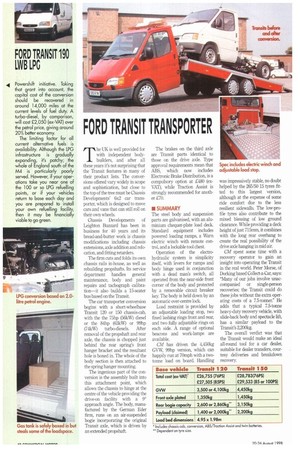FORD TRANSIT 190 INB LPG
Page 43

Page 44

If you've noticed an error in this article please click here to report it so we can fix it.
Ford's contribution to the budding alternative fuel market is the Transit Bi-fuel. Based on the 113hp 2.0-litre petrol-injected engine, it is offered in Liquefied Petroleum Gas (LPG) or Compressed Natural Gas ICNG) versions. In both cases the original petrol system is retained, with gas operation available at the press of a dashboard switch. The range of alternative-fuel Transits has recently been expanded to include all models apart from the top-weight 230 variants; CM has driven a 190 long-wheelbase panel van powered by LPG.
Alternative-Fuel Transits are currently supplied as third-party conversions (our test vehicle was converted by Tickford). However, from early next year Ford will be offering them as line-built products. The current conversions carry Full Ford approval, with Ford and the converter providing the warranty on their respective components. The LPG installation, which weighs 54kg dry, comprises a 68litre tank mounted at the front of the loadspace which supplies a combined evaporator/regulator through a system of safety valves and a small filter (which must be replaced annually). The vaporised fuel is then fed to a distributor which is controlled by data from the engine's ECU. The only bits the driver gets involved in are an extra filler cap and a change-over switch on the dash. The fuel gauge on this example takes the form of a stack of LEDs which extinguish as the contents are used up. Unlike some systems, which require the engine to be stationary, the Ford/Tickford system allows fuel selection on the move (petrol is recommended for cold starts).
• RUNNING ON LPG Tickford estimates a 2-3% loss of power when running on LPG, but out on the road the difference is barely noticeable, with the DOHC engine performing briskly in both modes. Unfortunately, when running on gas our test van suffered from a hesitation when reapplying the power, particularly after changing gear. This made stop-start motoring in town traffic, where it should have been in its element, rather erratic and prone to stalling. Tickford assures us that this was an isolated fault and is not characteristic of the type.
At the time of writing, the forecourt price of LPG is 39p/lit, compared with 79p/lit for unleaded petrol, although LPG's lower energy content means a litre will propel the Transit for 20% less distance than petrol. The LPG conversion costs £1,469 (ex-VAT), half of which may currently be paid by the Government's IP. 41 Powershift initiative. Taking that grant into account, the capital cost of the conversion should be recovered in around 14,000 miles at the current levels of fuel duty. A turbo-diesel, by comparison, will cost 22,050 (ex-VAT) over the petrol price, giving around 20% better economy. The limiting factor for all current alternative fuels is availability. Although the LPG infrastructure is gradually expanding, it's patchy; the whole of England south of the M4 is particularly poorly served. However, if your operations take you near one of the 100 or so LPG refuelling points, or if your vehicles return to base each day and you are prepared to install your own refuelling facility, then it may be linancialb, viable to go green.








































































































